Roots of Polynomials (Edexcel A Level Further Maths): Revision Note
Exam code: 9FM0
Roots of quadratics
How are the roots of a quadratic linked to its coefficients?
Because a quadratic equation
(where
) has roots
and
, you can write this equation instead in the form
Note that
It is possible that the roots are repeated, i.e. that
You can then equate the two forms:
Then (because
) you can divide both sides of that by a and expand the brackets:
Finally, compare the coefficients
Coefficients of x:
Constant terms:
Therefore for a quadratic equation
:
The sum of the roots
is equal to
The product of the roots
is equal to
Unless an exam question specifically asks you to prove these results, you can always use them without proof to answer questions about quadratics
Related Roots
You may be asked to consider two quadratic equations, with the roots of the second quadratic linked to the roots of the first quadratic in some way
You are usually required to find the sum or product of the roots of the second equation
The strategy is to use identities which contain
and
(where
and
are the roots of the first quadratic)
If you know the values of
and
from the first quadratic, you can use them to help find the sum or product of the new roots
If the second quadratic has roots
and
, then use the identities:
If the second quadratic has roots
and
, then use the identities:
You can then form a new equation for a quadratic with the new roots
This is done by recalling that a quadratic with a given pair of roots can be written in the form x2 – (sum of the roots)x + (product of the roots) = 0
Be aware that this will not give a unique answer
This is because multiplying an entire quadratic by a constant does not change its roots
You can use this fact, for example, to find a quadratic that has a particular pair of roots AND has all integer coefficients
See the worked example below for an example of how to do some of this!
Worked Example
The roots of an equation are
and
.
a) Find integer values of a, b, and c.

b) Hence find a quadratic equation whose roots are and
.
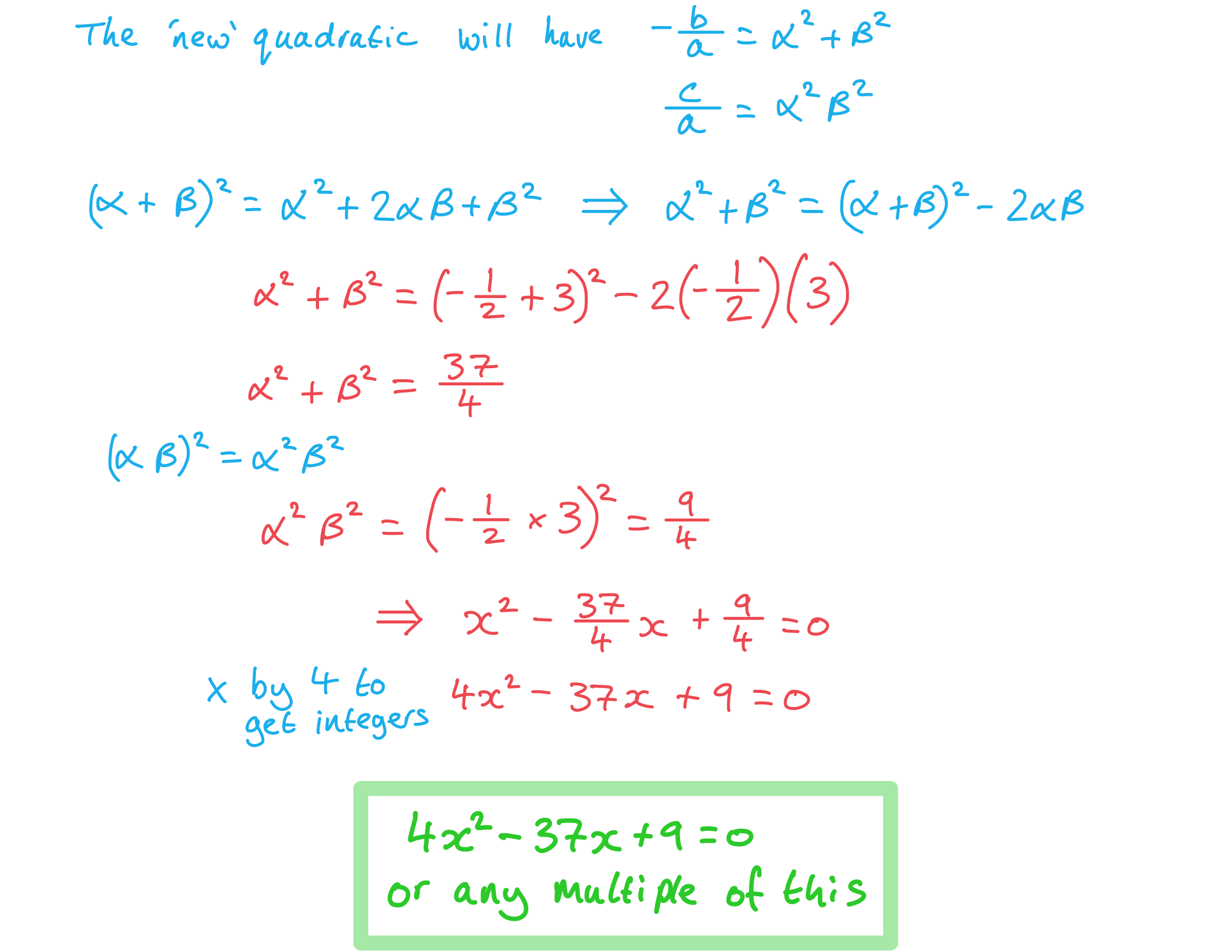
Roots of cubics
How are the roots of a cubic linked to its coefficients?
Because a cubic equation
(where
) has roots
,
and
, you can write this equation instead in the form
Note that
It is possible that some of the roots are repeated, i.e. that some or all of them are equal to each other
You can then equate the two forms:
Then (because
) you can divide both sides of that by a and expand the brackets:
Finally, compare the coefficients
Coefficients of x2:
Coefficients of x:
Constant terms:
Therefore for a cubic equation
:
The sum of the roots
is equal to
The sum of roots
can also be denoted by
The sum of the product pairs of roots
is equal to
This ‘sum of pairs’
can also be denoted by
The product of the roots
is equal to
The product of roots
can also be denoted by
See quartic equations where using this ‘sum of triples’ notation makes more sense!
Unless an exam question specifically asks you to prove these results, you can always use them without proof to answer questions about cubics
Related Roots
You may be asked to consider two cubic equations, with the roots of the second cubic linked to the roots of the first cubic in some way
You are usually required to find the sum or product of the roots of the second equation
The strategy is to use identities which contain
,
, and
(where
,
and
are the roots of the first cubic)
If you know the values of
,
, and
from the first cubic, you can use them to help find the sum or product of the new roots
If the second cubic has roots
,
, and
, then use the identities:
i.e.,
If the second cubic has roots
, then use the identities:
i.e.,
If the second cubic has roots
,
, and
, then use the identities:
You can then form a new equation for a cubic with the new roots
This is done by recalling that a cubic with three given roots can be written in the form
Be aware that this will not give a unique answer
This is because multiplying an entire cubic by a constant does not change its roots
You can use this fact, for example, to find a cubic that has a particular pair of roots AND has all integer coefficients
Worked Example
a) Given the cubic equation , find
,
, and
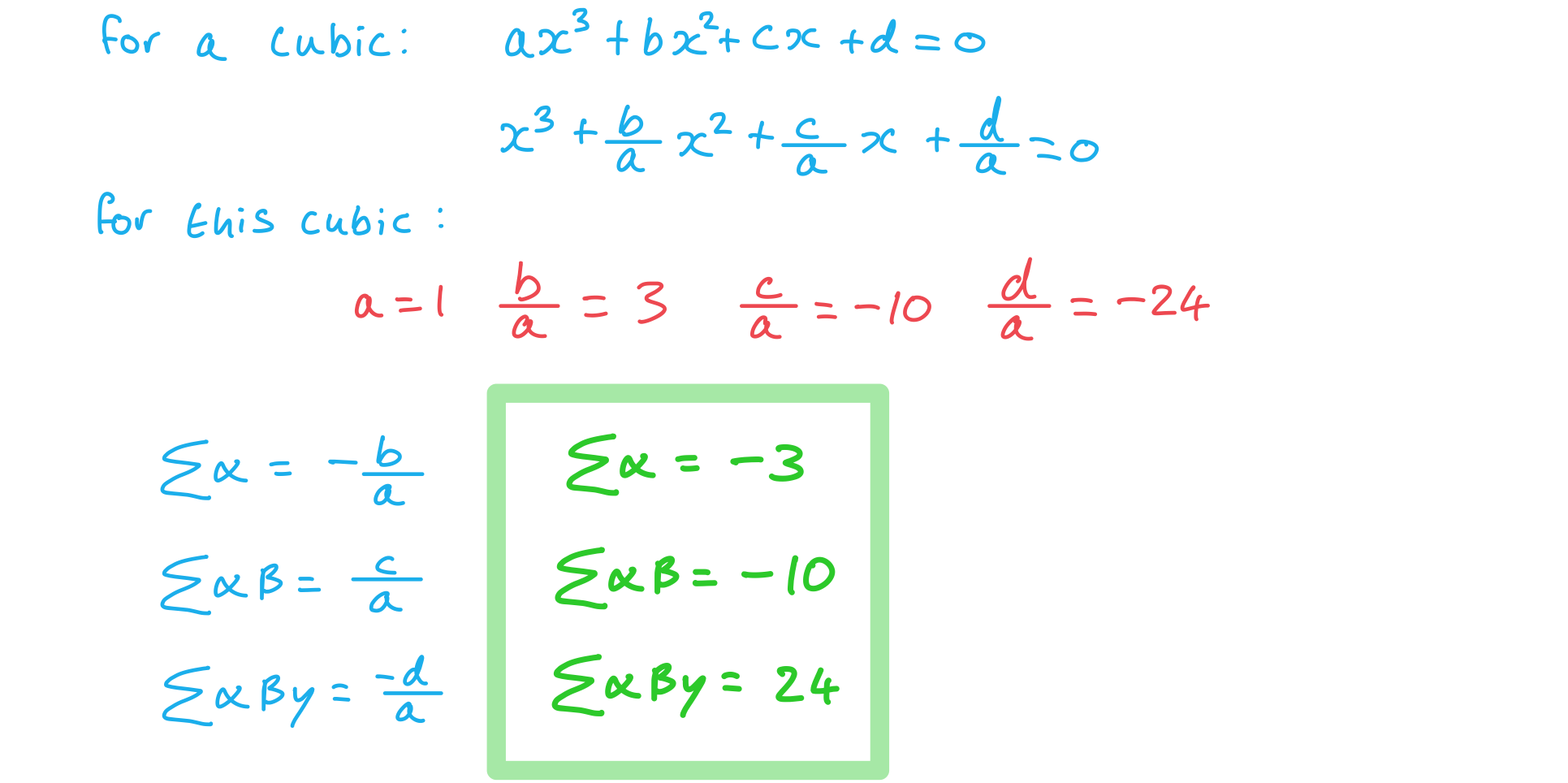
b) Another cubic has roots ,
, and
. Find
.
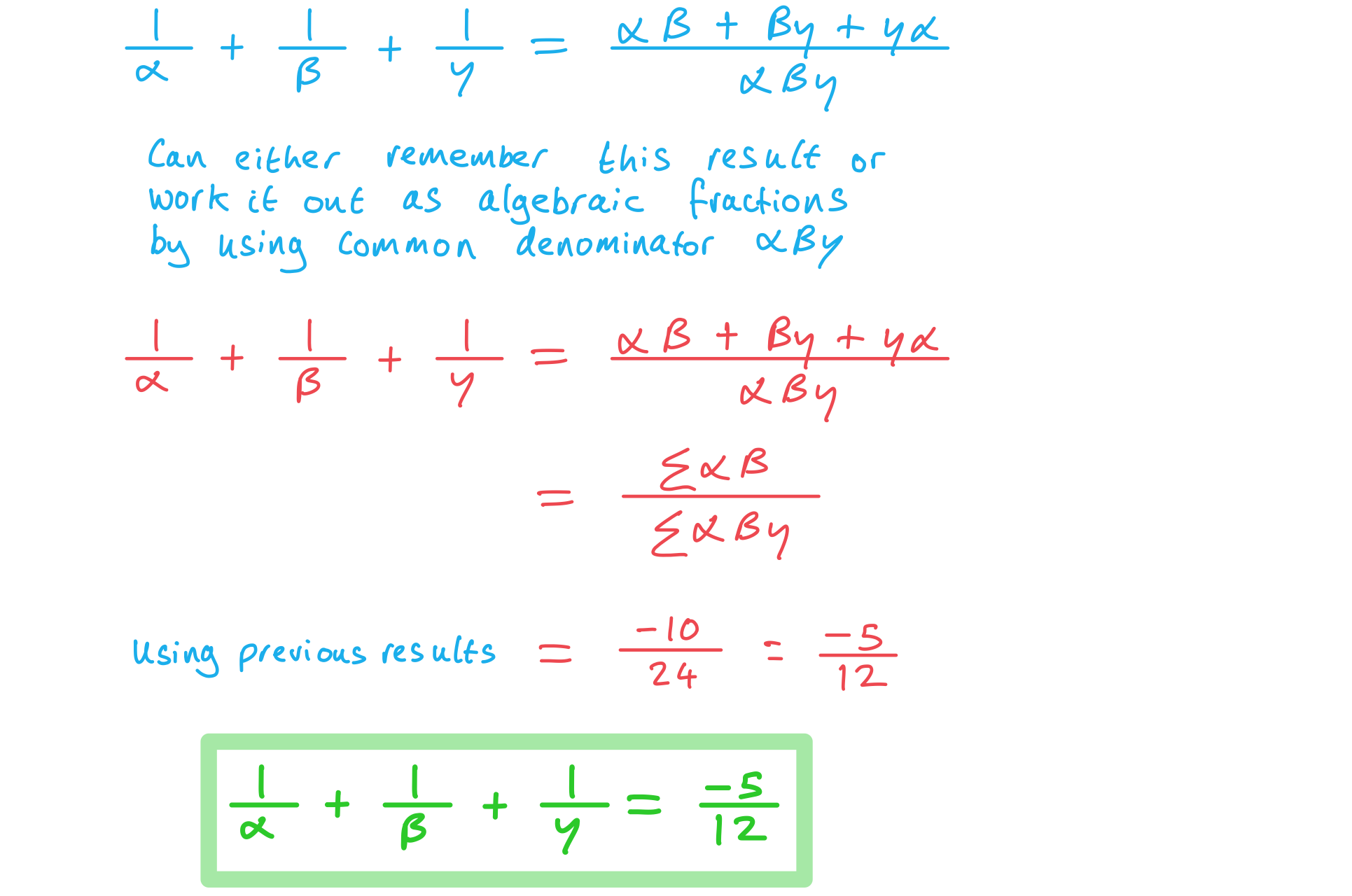
Roots of quartics
How are the roots of a quartic linked to its coefficients?
Because a quartic equation
(where
) has roots
,
,
and
, you can write this equation instead in the form
Note that
expands to
It is possible that some of the roots are repeated, i.e. that some or all of them are equal to each other
You can then equate the two forms:
Then (because
) you can divide both sides of that by a and expand the brackets:
Finally, compare the coefficients
Coefficients of x3:
Coefficients of x2:
Coefficients of x:
Constant terms:
Therefore for a quartic equation
:
The sum of the roots
is equal to
The sum of roots
can also be denoted by
The sum of the product pairs of roots
is equal to
This ‘sum of pairs’
can also be denoted by
The sum of the product triples of roots
is equal to
This ‘sum of triples’ can also be denoted by
The product of the roots
is equal to
The product of roots (or ‘product of fours’)
can also be denoted by
Unless an exam question specifically asks you to prove these results, you can always use them without proof to answer questions about quartics
Related Roots
You may be asked to consider two quartic equations, with the roots of the second quartic linked to the roots of the first quartic in some way
You are usually required to find the sum or product of the roots of the second equation
The strategy is to use identities which contain
,
,
, and
(where
,
,
and
are the roots of the first quartic)
If you know the values of
,
,
, and
from the first quartic, you can use them to help find the sum or product of the new roots
If the second quartic has roots
,
,
and
, then use the identities:
i.e.,
(Note that you will not be asked about a quartic with roots
and
)
If the second quartic has roots
,
,
and
, then use the identities:
You can then form a new equation for a quartic with the new roots
This is done by recalling that a quartic with four given roots can be written in the form
Be aware that this will not give a unique answer
This is because multiplying an entire quartic by a constant does not change its roots
You can use this fact, for example, to find a quartic that has a particular pair of roots AND has all integer coefficients
Worked Example
a) The roots of are
and
. Find
, and
.
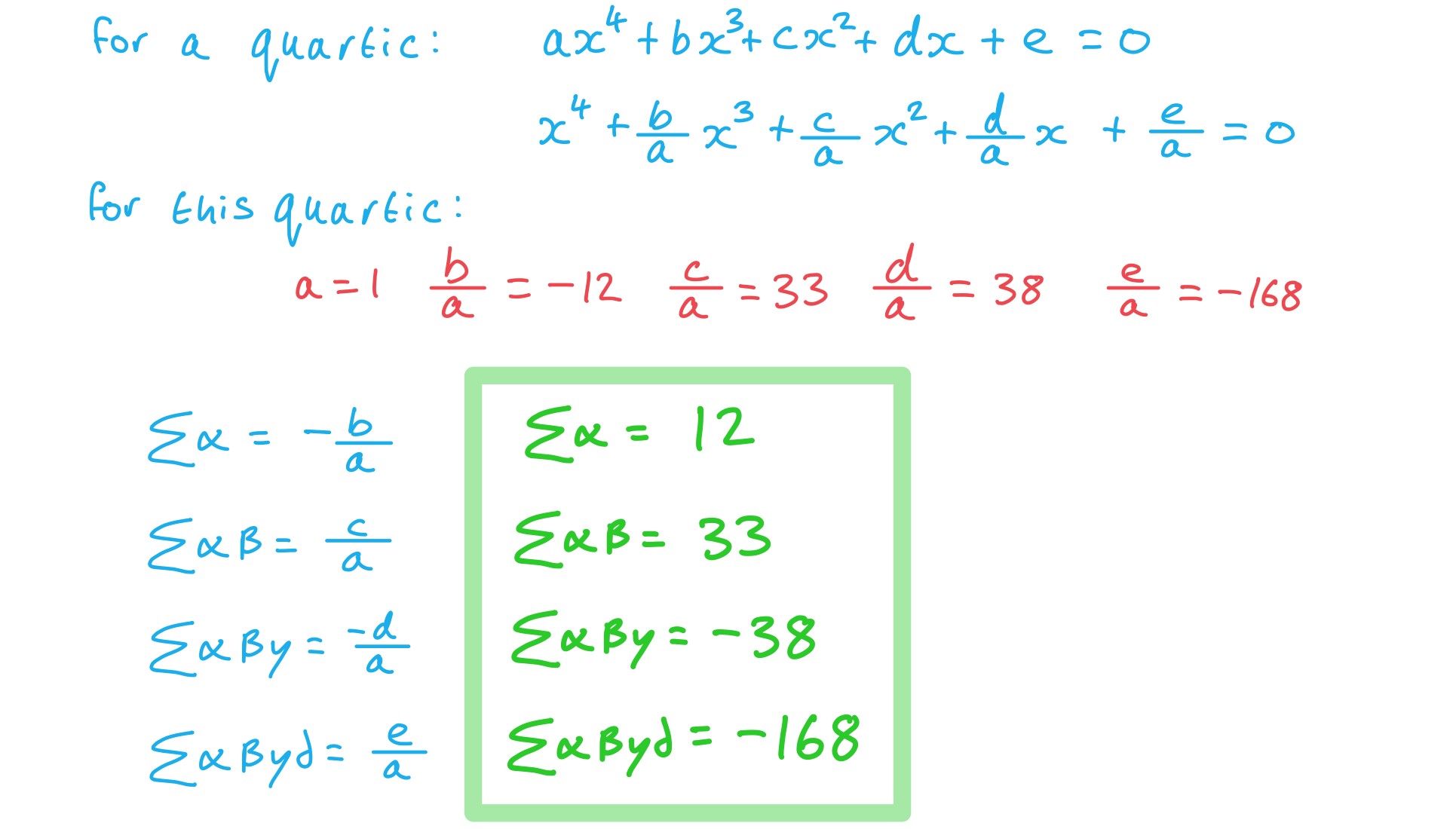
b) Another quartic has roots and
. Find the value of
.
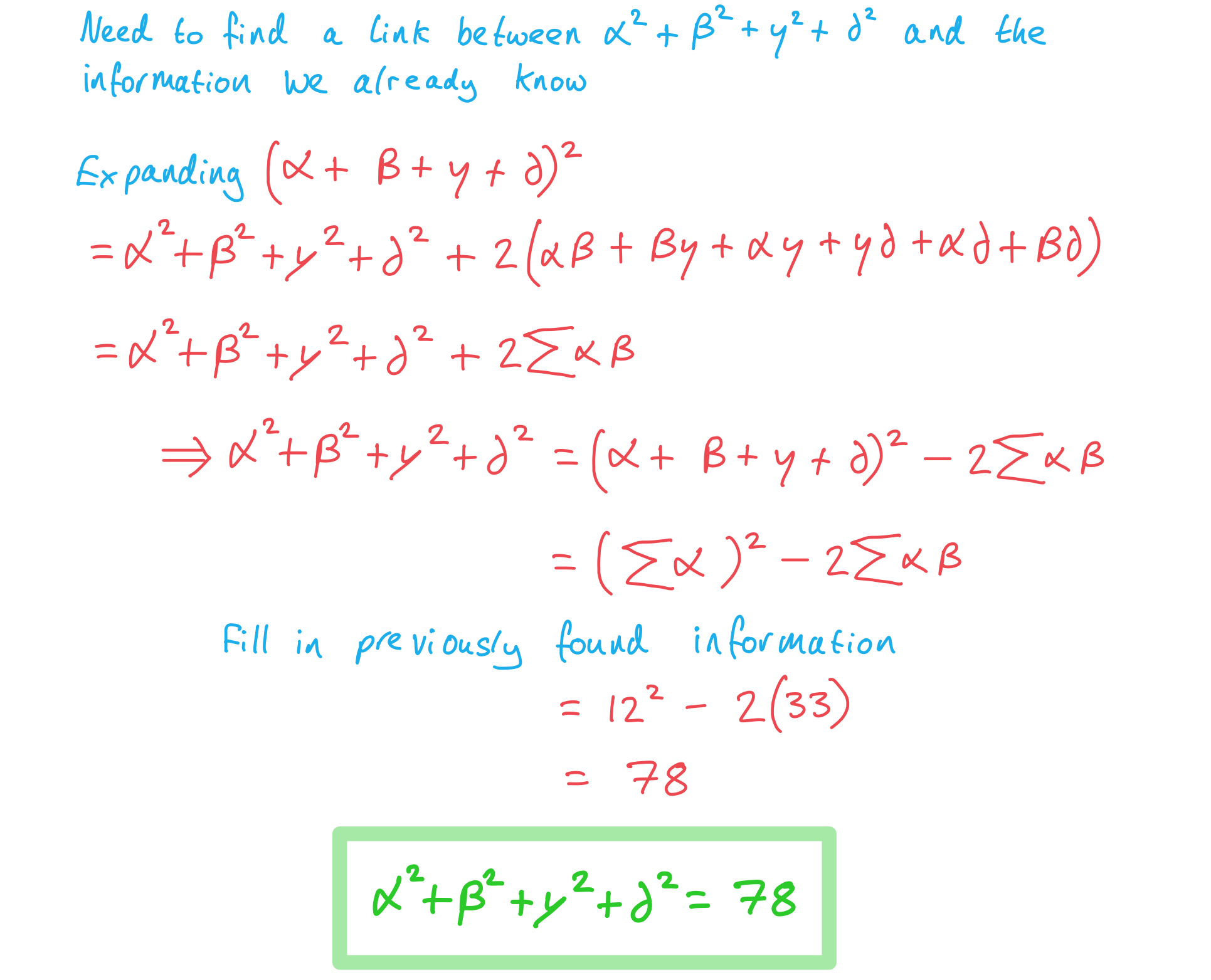
Roots of polynomials
What is the general pattern linking the roots to the coefficients of a polynomial?
By looking at the links between the coefficients and the roots of quadratics, cubics, and quartics, you can see that a pattern emerges, which also holds true for higher order polynomials
It is useful to use sigma notation to keep expressions for sums of roots concise
For a quartic with roots
, for example:
The sum of the roots
is denoted by
The sum of the pairs of roots
is denoted by
The sum of the triples of roots
is denoted by
The sum of the sets of fours (in this case just one term)
is denoted by
The table below summarises the relationships between the coefficients and roots of quadratics, cubics, and quartics:
| Roots | Roots | Roots |
| |||
|
|
How can I find sums and products of related roots?
You may be asked to consider a second equation, that has roots linked to the roots of the first equation in some way
You are usually required to find the sum or product of the roots of the second equation
The strategy is to use identities containing
, and/or
(depending on the question and the degree of the polynomial)
If you know the value of the roots from the first equation, these identities can help you find the sum or product of the roots of the second equation
The table below shows useful identities for finding a new quadratic equation whose roots are related to the roots
and
of the original quadratic equation
In each case the sum or the product of the ‘new roots’ can be linked back to
or
for the original equation
Roots of new Equation | Useful Identities to find sums and products of new roots |
Similar identities that could be useful for cubics and quartics are listed earlier in this revision note in the cubics and quartics sections
A good place to start if the new roots are squared, is by considering
or if the new roots are cubed, then start by considering
or if the new roots are reciprocals (i.e.,
, etc.), then start by adding the new roots together to form a single algebraic fraction
Examiner Tips and Tricks
Although you may be asked to tackle questions on this topic showing full working and without relying on a calculator, you can still use your calculator to check your work by finding the roots of a polynomial in the polynomial solver
You can then use these to check your answers for sums of roots, products of roots, etc.
Worked Example
a) Given a polynomial equation of order 5 (a quintic); , make 5 conjectures linking the coefficients a, b, c, d, e, f to its roots
.
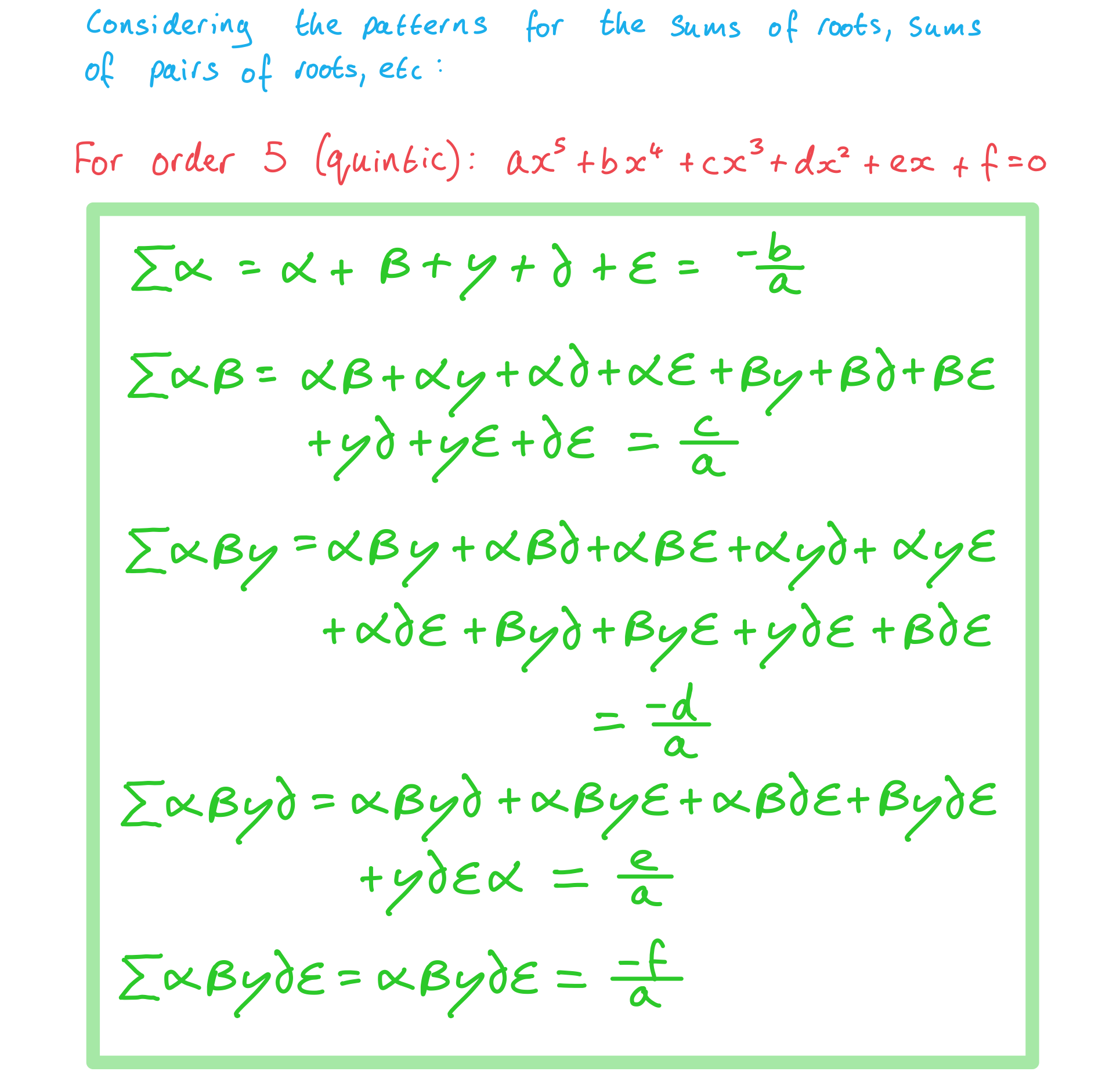
b) Test your conjectures on the example: which has roots
.
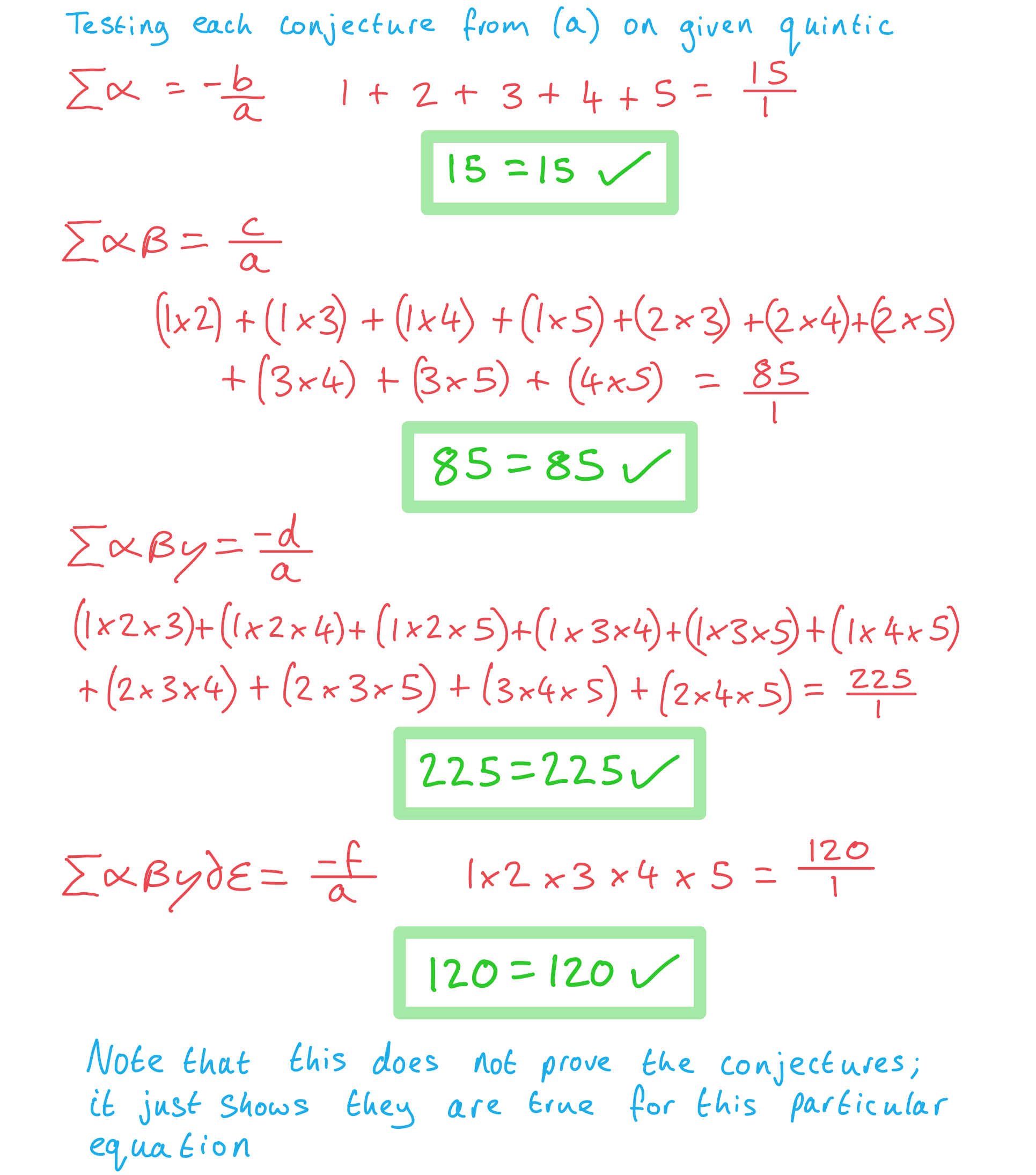

Unlock more, it's free!
Did this page help you?